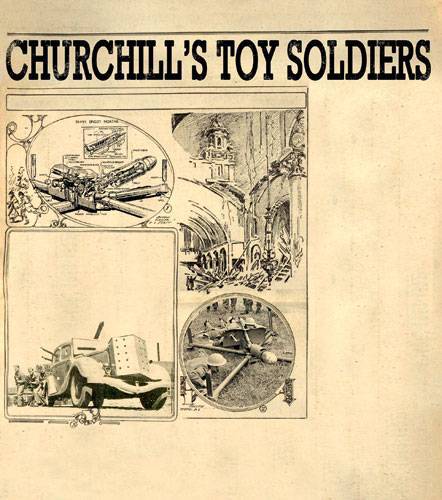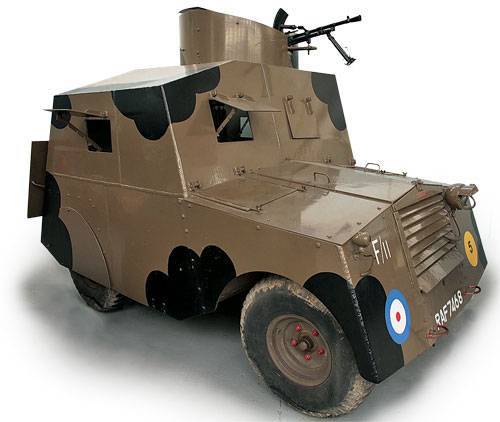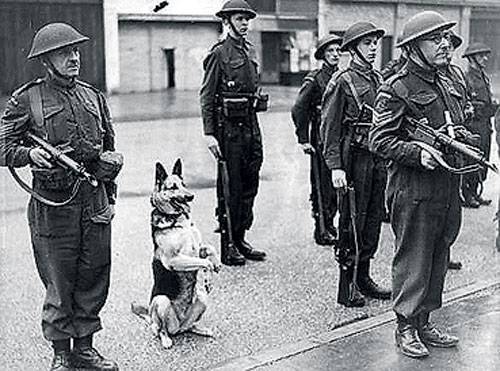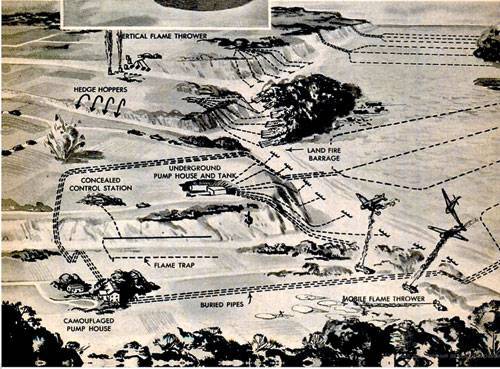Churchill's toy soldiers, the militia

Ersatz armored cars
In the face of a shortage of armored vehicles, the militia converted personal vehicles into combat vehicles. The main transformation was the addition of several sheets of iron on the doors and on the windows of an ordinary car, as well as the installation of a light machine gun on the roof. In the improvised armor it was often possible to find out the details of the radiators or just the roofing tin.
“The final victory of Germany over England is now only a matter of time. Enemy offensive operations on a large scale are no longer possible. ” The chief of staff of the Wehrmacht’s operational leadership, General Jodl, who wrote these lines on 30 June 1940, was in a great mood. The week before that, France had fallen, and at the beginning of the month the Anglo-French and Belgian troops barely managed to get their feet off the continent, leaving the Germans with their vehicles.
Nothing prevented the Third Reich from finalizing and finalizing the plan of Operation Sea Lion to capture Britain. The British people, whose troops, after fleeing from Dunkirk, remained virtually without tanks and artillery, could oppose the Germans a strong sea and air fleet, as well as unshakable patriotism, the spirit of resistance. In the face of mortal danger, Churchill managed to rally the people, and the nation was ready to fight to the last drop of blood.
14 May 1940, the War Minister, Anthony Eden, speaking on the radio, urged men between the ages of 16 and 65 to join the newly-organized “Voluntary local self-defense units” (later “Home Guard”, Home Guard). By the end of the month, these units already had 300 000 fighters, and soon their number increased to 1,5 million. The most pressing problem was the provision of volunteers weapons, uniform and equipment. At first, homegards were serving in their everyday clothes and armed with anything — hunting or sporting guns, or even golf clubs and forks. Realizing that the German tanks couldn’t stop the agricultural implements, the military ministry quickly began to develop and mass produce the simplest weapons.

In 1940, Standard Motor Company launched into mass production the compact armored car Standard Car 4 x 2, which was popularly nicknamed Beaverette (“Bobrik”). In just two years, 2400 armored vehicles were made, both in the part of the British militia and in the regular army. The first modifications of the “beaver” had a body that was open at the top and the back: this nullified almost all the protective functions of the car. The illustration shows a modification of the Mk III Beaverbug, characterized by a shortened chassis, the presence of an armored roof and a gun turret
Smith without Wesson
Homeguard's primary task was the destruction of enemy tanks and armored vehicles. Since the Boys 13,97-mm anti-tank rifle in service could no longer fully correspond to the anti-tank rank, various extravagant structures began to enter the militia.
One of them is a three-inch smooth-bore grenade launcher developed by Trianco Engineering Company. His chassis was a two-wheeled wagon, at the same time serving as a calculation with armor: to bring the weapon into a fighting position, all that was needed was to knock it over on its side. In order for homewards in the heat of battle not to confuse and not put the weapon upside down, the right wheel (it is also a swinging bollard) was made with a concave bottom, the second, on the contrary, with a convex. The gun was easily moved by the efforts of two people, but for long distances it was towed by ordinary civilian cars or even motorcycles. The self-propelled version on the chassis of the Universal Carrier armor conveyor was also developed. Shooting could be conducted as high-explosive and armor-piercing grenades. The range of armor-piercing ammunition was 180 m, high-explosive - 450 m, but the area could be fired at a distance of 600 m, which allowed the scattering of grenades at such a distance.
Another exotic anti-tank has become the "Blacker bombard". Conceived back in 1930 by British Army Lieutenant-Colonel Stuart Blacker, the 29-mm bombardor could fire grenades based on a two-inch mortar mine with a high-explosive anti-tank weight 9,1 kg and a fragmentation anti-personnel weight 6,35 kg. Smoke powder was used as a throwing substance - of course, this was not done from a better life.
The weapon was bulky (50 kg weighed the bombard itself and more than 100 kg - the machine for it), with disgusting accuracy (an anti-personnel grenade at maximum distance could get into the football field, and when firing at point-blank weapons, fragments threatened to hit the gun; to get into the tank, the fire was required to open with 50 – 90 m), so it is not surprising that even in the homeguard the bombers were treated badly. The situation was aptly described by the commander of the 3 Battalion of the Wiltshire militia: “I was told that the 50 of these guns had been allocated to my battalion. But I do not see the possibility of using them, so that they will simply add to the heaps of scrap metal already lying on the outskirts of the Wiltshire villages. ” Despite all the problems, the 22 000 “bombardment” with full ammunition was in service with the homeguard until 1944 and even were delivered to the countries of the anti-Hitler coalition — for example, during the 1941 – 1942 period, the Red Army had 250 guns from Lieutenant Colonel Blacker.
Hammer as an anti-tank tool
Military instruction no. 42 “Tank: hunting and destruction” for militias offered even more exotic ways of disabling armored vehicles. For example, it was proposed to use cables like aerofinishers, forcibly stopping planes on the deck of an aircraft carrier; to attach such a cable to the trees.
Another way to stop the car required the well-coordinated work of four people from the team of "tank hunters" homeguard. Crouching behind a wall at home or in roadside bushes, the hunters waited until the tank reached them. After that, two team members ran out of the shelter with the rail at the ready (however, as noted in the manual, instead of the rail, you can also use a crowbar, crowbar, hook, or just a wooden beam of suitable thickness) and stuck it into the undercarriage, between the roller and the sloth. After the chassis had jammed, the third calculation number was rolling a blanket with which the stuck end of the rail was wrapped with gasoline, and the fourth homeguard set it all on fire.
The guide also considered plan "B" - in case the militia could not get any rails, not gasoline. According to him, a hammer (it could be replaced with an ax, which was part of the obligatory set of “hunters”) and grenades were enough to remove the tank. With a hammer in one hand and a grenade in the other, the fighter had to wait for the enemy machine on the dais (second floor of the building, tree, hill) and, seizing the moment, jump onto it from above. Then, Homevard should be banging with a hammer on the tower and, waiting for the surprised fascist to pop out of the hatch, throw the grenade inside ...

Incendiary English
A separate point in the homeguard’s defense system was firing — any Pyromaniac would be delighted if he could get acquainted with the devices designed to immerse the Germans who landed in the depths of fiery hell.
First, the fire mixture (25% gasoline, 75% diesel) was simply spilled - by gravity from a slope or using simple pumps. It was calculated that to create a six-minute fire of 0,5 size x 1,5 m required 910 l fire mixture. Fuel could also be “packed” in barrels, turning them into improvised incendiary land mines. Buried on the road, they were set on fire using an electric detonator.
Soon, an improved landmine was developed - it could be disguised on the side of the road, and at the right moment, the expelling charge sent the burning barrel directly to the column of equipment. Subsequently, this landmine was once again modernized: now the fuel flew to the enemy not in the barrel, but in the form of a burning jet, pushed out by compressed nitrogen. A roaring pillar of flame, blinding the road in the blink of an eye, made an indelible impression on the testers - what would happen to the Germans would be terrible to imagine.
However, the British were not limited to land mines. At homeguard, the home-made infantry "Harvey Flamethrower" spread. It was a 100-liter fire tank and a cylinder with 113 compressed air decaliters. Calculation of two people carrying weapons on a specially made iron trolley.
In order to carry the flamethrower more conveniently, the 24-th Stafordshire Tettenhol home guard battalion constructed a self-propelled version on the chassis of an old car Austin 7. The engine with the case was removed from the car and a pump was added, a 200-liter fuel barrel and a stool for the flame thrower. In theory, the militiaman had to water the enemy from a distance of 22 m for three minutes, but, most likely, he would simply have become a kamikaze, having left the position and exploded.
Finally, the coastal defense system included the widest use of combustible mixtures. So, on the beaches, as well as along the bottom, at some distance from the coast, it was planned to lay pipes with valves placed at regular intervals in them. When the landing craft approached close to the shore, the valves opened, the oil from the pipes floated and set on fire. The implication was that the German order would not endure landing in dense thick smoke and the suffocating airborne units would fail.
Flamethrowers of the air defense, meanwhile, were waiting for the Luftwaffe planes - for example, the heavy stationary version gave out a vertical torch with a height of about 30 m. Another heavy, but self-propelled version of an improvised armored car had a slightly smaller vertical throwing range. On the shore, the Basilisks were also on duty, homemade combat vehicles, which were Bedford QL armored trucks with flamethrowers.
In contrast to the various means of throwing fire was the militia and combat water cannon mounted on the Universal Carrier armored personnel carrier. A thick hose fed to a powerful hydrant behind the shield of an almost unlimited number of “ammunition”, which acted almost silently and inconspicuously.

Elements of strategy
Numerous guides, designed specifically for homeguard, provided absolutely all situations possible in battle. In theory, the militia could withstand tank corps, infantry platoons, and aircraft attacks. In reality, homeguard units would be torn down during the first serious attack of the enemy
London Improvisational Orchestra
Another problem facing homeguard was the lack of armored vehicles. Since even the army lacked it, it was necessary to get it out on its own.
Across the country, from home garages to the shops of huge factories, the militia began to convert personal vehicles into ersatz armored cars. The main transformation was the addition of several sheets of iron on the doors and windows of the family car, as well as the installation of a light machine gun on the roof. However, where the production capabilities allowed, variants more similar to armored cars were born: with fully closed armored corps and one or two machine guns in the turrets. Even the buses (including double-decker) and agricultural tractors were altered and booked in separate homeguard battalions. However, all these cars had extremely dubious combat value, since the hastily produced “armor” practically did not protect from bullets and fragments, and it was safe to forget about driving an overloaded chassis of old sedans and a coupe over rough terrain.
The first industrially produced ersatz armored car was the light reconnaissance armored vehicle Beaverette ("Bobrik"). The entire manufactured armor rental went entirely to the needs of the armed forces, so the body of the Standard Motor Company’s armored car had to be made of boiler iron with a thickness of 9 mm fixed on a wooden frame. The armament of an open-top machine was a Bren 7,71-mm machine gun and a Boys anti-tank rifle.
According to the Biveretta staff, a crew of three people was supposed to be: a gunner and two drivers (it was believed that the first driver would die as soon as the machine entered the battle, so a spare one was to be present). In subsequent modifications, the length of the chassis of the machine was reduced, the thickness of the "armor" grew to 12 mm, and the hull became completely closed and got a tower. In total, the 2800 "Biverett" was released, individual copies served in Ireland right up to the beginning of the 1960-s.
Heavier "armored vehicles" were built on the basis of trucks. The London, Midland and Scottish Railway firm originally solved the problem of the absence of armor plates: a wooden box was mounted on the platform of a truck, inside of which there was another one, but of smaller size. In the gap between the walls, which was 152 mm, pebbles, rubble and small stones were poured. In the walls of the boxes there were loopholes with steel valves, and the cabin glass was protected by boiler iron. The machine, which received the designation Armadillo Mk I, was armed with a machine gun and could withstand machine-gun fire. Total was released 312 armored cars ersatz.
Armadillo Mk II, 295 copies of which were made on the basis of a three-ton Bedford truck, had an elongated box, as well as protection of the radiator and gas tank. The 55 Armadillo Mk III had a shorter box, but it was armed with a one-and-a-half-pound gun.
The company Messers Concrete Ltd went the other way - the old commercial two- and three-axle trucks received reinforced concrete armor that could withstand even an armor-piercing bullet. Machines under the common brand Bison had various forms of concrete boxes and cab protection.
In general, fortunately for the militia, none of the described suicidal methods and mechanisms of opposition to the Germans in reality was so embodied and was not. Hitler soon attacked the USSR, and he was not up to landing on British territory.
Lieutenant Colonel British Army Stuart Blacker developed a lot of exotic weapons. At one time he offered to put on board even ... a crossbow. A light mortar-mortar, called the Blacker bombardment, despite all the design flaws, was nevertheless produced in a proper number of copies and entered the regular units of the British militia. The 29 millimeter bombardment could fire several types of grenades, but it had a monstrous weight (more than 150 kg with a machine tool) and such projectiles spread that it was possible to hit the target from a distance of no more than 40 – 50 m. The first bombarders were made the end of 1941 of the year, and by July of the 1942-th in the parts there were more than 22 000 guns. The commanders and soldiers did not like a clumsy mortar, strongly discouraged from its use and even secretly sold the incoming bombers to the metal.
In the militia, insane constructions were used at all - for example, the Northover projector's gunshot thrower for bottles was made in quantities of 18 919 pieces. Like all homeguard weapons, the bottle was extremely simple and was a barrel-pipe with a bolt. Everything in the collection cost £ 10 (about $ 38) - despite the fact that the Thompson submachine gun cost over $ 200!
The fire from the gun was conducted bottle № 76 (63,5 mm caliber, a pound of weight), white phosphorus, which burns at a temperature exceeding 800 ° C and ignites on contact with air. Effective range was 91 m, maximum -. 274 m Due to low weight (27,2 kg) Northover projector is usually placed on the cradle motorcycles or even garden wheelbarrows. The main purpose of the calculation was the tanks, but, judging by some of the photos, the Homewards were going to shoot from the gun and low-flying aircraft ...
- Artem Platonov
- http://www.popmech.ru"rel =" nofollow ">http://www.popmech.ru
Information